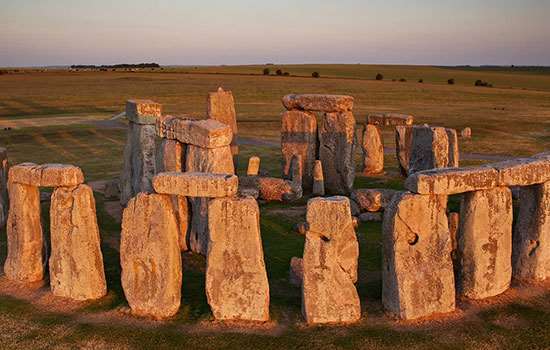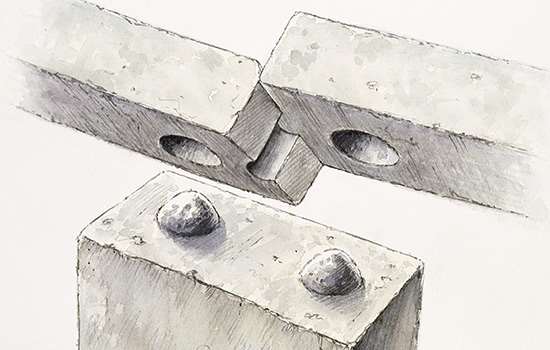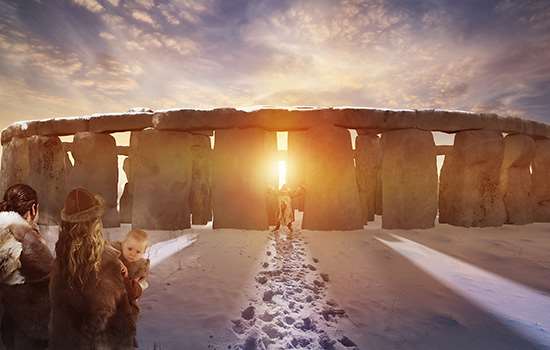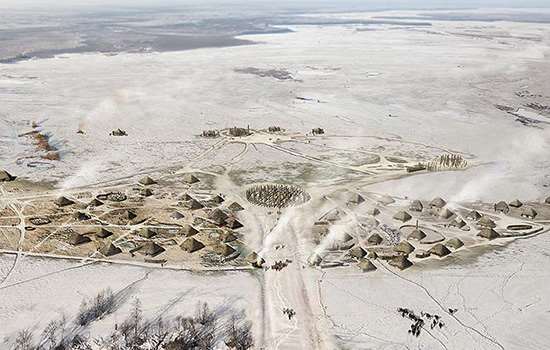Aligning with the sun
The sarsen stones, put up in at the centre of the site in about 2500 BC, were carefully placed to line up with the movements of the sun. If you were to stand in the middle of the stone circle on Midsummer’s Day, you would see the sun rise just to the left of the Heel Stone, an outlying stone north-east of the circle. Archaeologists have found a large stone hole to the left of the Heel Stone which may have held a partner stone: if so, the two stones would have framed the sunrise.
On Midwinter’s Day, the sun would originally have set between the two uprights of the tallest trilithon (two upright stones capped by a horizontal lintel). It would have dropped down over the Altar Stone, a sandstone block which was placed across the solstice axis. Today, this effect has been lost because half of the trilithon has fallen. But a laser survey of Stonehenge has shown that the stones that framed the solstice axis were the most carefully shaped, with vertical sides that framed the movement of the sun.
The whole layout of Stonehenge is therefore designed in relation to the solstices, which are the extreme limits of the sun’s movement. The solstice axis is also marked by the Station Stones, which are placed at the corners of a rectangle around the edge of the surrounding circular ditch. The short sides of the rectangle are parallel to the main alignment at Stonehenge.
The late Neolithic monument known as the Avenue, made up of parallel banks and ditches, links Stonehenge to the nearby river Avon. And it is also linked to the movements of the sun – its final, straight stretch close to Stonehenge is aligned on the north-east to south-west solar axis.
Recent excavations across the Avenue have found that the earthworks appear to follow the line of some ridges, with gullies between them (known as periglacial stripes). These are natural features created by glaciation. But it’s possible that Neolithic people noticed that the ridges and gullies lined up with the solstice, and may have chosen to build Stonehenge here as a result.
A Neolithic calendar?
Marking the movements of the sun was clearly important to the people who built Stonehenge, as they went to such great lengths to align the monument with them. But we have few clues as to what they did here. Excavations show that the area within the stone circle seems to have been kept clean of everyday debris, and we can imagine that people came here to celebrate midsummer and midwinter.
The people who built Stonehenge were farmers, herders and pastoralists. The changing seasons would have been of immense significance to them, both practically – the seasons dictated what they could grow and when – and also probably spiritually. So Stonehenge is likely to have been much more than a calendar. Midsummer and midwinter may have been important times of year to remember the dead or to worship a solar deity.
Midwinter celebrations
It’s thought that midwinter, rather than midsummer, may have been the more important focus for the people who built Stonehenge. This is partly because the alignments towards the setting midwinter sun are ahead of you when walking up the Avenue and entering the monument, just as the most important parts of a church lie in front of you when you enter.
We also know that people gathered to feast at midwinter at Durrington Walls, the settlement north-west of Stonehenge where its builders and users lived. From the pig bones found buried there in pits and rubbish dumps, we know that most of the pigs were being killed in midwinter. Evidence from both cattle and pig bones found at Durrington Walls shows that they had been brought there over long distances, suggesting that midwinter was a time when people gathered in great numbers to conduct ceremonies at the monuments and feast together.
Why celebrate and gather at midwinter? Winter is a time of danger. The nights are long and the days cold, and after the bounty of summer and autumn, stocks of food are beginning to dwindle. The ground is frozen solid. Nothing seems to grow. The sun’s dim light barely scrapes above the horizon, and around the solstice the setting sun seems to stand still. It might have seemed that the sun – giver of light, warmth and life – was dying. So it was important to honour the sun to ensure its return.
But then the sun starts to move northwards again. It’s still cold, and the nights are still long, but as the sun moves north it’s clear that the days will grow longer and warmth will return.
Stonehenge and the moon
Whether Stonehenge was aligned with the movements of the moon as well as the sun is debatable. Whereas the sun follows a cycle that takes place roughly over the course of a year, the moon’s cycle is much more rapid. Moonrise and moonset move from their northernmost to southernmost limits and back again in just a month. For ancient people the light of the moon would have been useful at night, especially in midwinter, and the regular lunar phases would have been a convenient way to measure time.
But the movements of the moon have a further cycle. The limits of moonrise and moonset change over a period of about 18.6 years. The period when moonrise and moonset are furthest apart is known as the ‘lunar major standstill’, and the period when they’re closest together is known as the ‘lunar minor standstill’.
It’s possible that the one major standstill was marked during the early phase of Stonehenge. During this period, particularly between about 3000 and 2800 BC, people were burying their cremated dead in the ditch and bank of the henge, and in the so-called Aubrey Holes – 56 pits within the ditch which held upright timber posts or stones. These cremations are clustered in the south-eastern part of the monument, in the direction of the most southerly rising position of the moon, where three timber posts were set into the bank. The long axis of the rectangle formed by the four Station Stones also shares this orientation, in the direction of the southernmost moonrise at the major standstill.
So there may have been a close association between the moon and the bones of the cremated dead.
The stars and planets
There is no evidence that the people who built Stonehenge marked the midpoints between the solstices, in spring and autumn. Although people today gather at Stonehenge at the spring and autumn equinoxes to watch the sunrise, archaeo-astronomers think it unlikely that the equinoxes meant anything to prehistoric people. The stars and visible planets may also have been important to people in prehistory, but it is impossible to know any beliefs relating to them.
The gradual changes caused by the precession of the rotational axis of the Earth means the rising and setting positions of the stars have changed over the centuries, and so the night sky above Stonehenge today is not the same as the one our ancestors would have seen thousands of years ago.
A solar monument complex
Other monuments in the Stonehenge landscapes were also built to align with the movements of the sun. Woodhenge, a timber monument near Durrington Walls, was built on the same axis, aligning with the midwinter and midsummer solstices. The nearby timber monument known as the Southern Circle is orientated towards the midwinter sunrise, and has an avenue leading down to the Avon that is aligned on the midsummer sunset.
These alignments might suggest that people undertook processions and ceremonies in one part of the Stonehenge landscape at dawn, and processed to another part at sunset.
Several other elaborate monuments dating from the late Neolithic period in Britain and Ireland were built to align with the sun. A similar alignment to the one at Stonehenge is known at the chambered tomb of Maeshowe on Orkney, the passage of which is orientated towards the setting sun at winter solstice. The entrance of the enormous passage tomb at Newgrange in county Meath, Ireland, was built to align with the midwinter sunrise: the sun shone directly into the chamber through a roof-box above the entrance, which was once closed with quartz blocks. This same midwinter dawn alignment is also known at Bryn Celli Ddu passage tomb on Anglesey, Wales.
Just as people used Stonehenge for the burial of the dead, so all these other monuments were also used for burials, and were places where people gathered for ceremonies and feasting. It may indicate that people in these distant places shared similar beliefs and religious practices.
Find out more
-

History of Stonehenge
Read a full history of one of the world’s most famous prehistoric monuments, from its origins about 5,000 years ago to the 21st century.
-

What is the winter solstice?
Find out what the winter solstice is, and why our ancestors might have built Stonehenge to align with the sun at the solstices.
-

What is the summer solstice?
Every year, thousands of people flock to Stonehenge at midsummer. What is the summer solstice, and what did it mean for prehistoric people?
-

Building Stonehenge
Stonehenge is a masterpiece of engineering. How did Neolithic people build it using only the simple tools and technologies available to them?
-

Ancient festive feasts at the time of Stonehenge
Dr Lizzy Wright delves deeper into the archaeological evidence for prehistoric midwinter feasting at Durrington Walls, near Stonehenge.
-

Neolithic food miles: travelling to Stonehenge
Where did all the people who gathered to feast at Durrington Walls come from? Dr Richard Madgwick explains what the latest research reveals.
